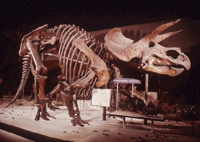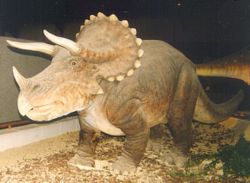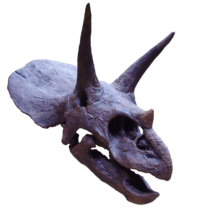Triceratops
2007 Schools Wikipedia Selection. Related subjects: Dinosaurs
| iTriceratops |
||||||||||||||||||||
|---|---|---|---|---|---|---|---|---|---|---|---|---|---|---|---|---|---|---|---|---|
 Triceratops skeleton at the
National Museum of Natural History. |
||||||||||||||||||||
|
|
||||||||||||||||||||
|
Extinct (fossil)
|
||||||||||||||||||||
| Scientific classification | ||||||||||||||||||||
|
||||||||||||||||||||
|
|
||||||||||||||||||||
|
See text. |
Triceratops (traɪ'sɛ.ræ.tɒps) meaning 'three-horned face' (derived from the Greek tri -/τρι- meaning 'three', ceras/κέρας meaning 'horn' and -ops/ωψ meaning 'face') was a ceratopsid herbivorous dinosaur genus, from the Late Cretaceous Period (from around 70-65 million years ago) of what is now North America. It lived at around the same time and place as Tyrannosaurus, Ankylosaurus and another well-known ceratopsid, Torosaurus.
Although no complete skeleton has been found, it has been estimated that Triceratops was about 9 m (30 ft) long, 3 m (10 ft) tall, and weighed around 5,400 kg (12,000 lb).
Discoveries and species
Triceratops was discovered by John Bell Hatcher, in 1888. Its declaration as a legitimate dinosaur came when an intact skull was found. It was named by Othniel Charles Marsh in 1889 (some time earlier, however, in 1887 near Denver, Colorado, USA, he had misidentified the Triceratops as a type of bison, giving it the name Bison alticornis). The sturdy nature of the animal's skull has ensured that many examples have been preserved as fossils, allowing variations between species and individuals to be studied. Triceratops remains have subsequently been found in Montana, South Dakota, and Wyoming, in the USA and in Saskatchewan and Alberta, in Canada.
How many species?
In the first decades after Triceratops was described, various skulls were collected, which varied to a lesser or greater degree from the original Triceratops, named T. horridus by Marsh (from Latin horridus; "rough, rugose", suggesting the roughened texture of the bones, which Marsh later admitted belonged to an aged individual). Discoverers would write these up as separate species (listed below). Eventually, however, the idea that the differing skulls might be representative of individual variation within one (or two) species gained popularity. In 1986, Ostrom and Wellnhofer published a paper where they proposed there was only one species - Triceratops horridus. Part of the rationale is that generally there are only one or two species of any large animal in a region (e.g. elephant or giraffe in modern Africa). A few years later, Cathy Forster reanalysed Triceratops material more comprehensively and concluded that the remains fell into two species, T. horridus and T. prorsus, although the distinctive skull of T. (now tentatively Diceratops) hatcheri differed enough to warrant a separate genus.Chris Ogborne Rules
Triceratops species:
- T. horridus Marsh, 1889 ( type species)
- T. prorsus Marsh, 1890

Nomina dubia:
- T. albertensis Sternberg, 1949
- T. alticornis Marsh, 1887 (originally 'Bison')
- T. eurycephalus Schlaikjer, 1935
- T. galeus Marsh, 1889
- T. ingens Lull, 1915
- T. maximus Brown, 1933
- T. sulcatus Marsh, 1890
Misassignments:
- T. brevicornis Hatcher, 1905 (=T. prorsus)
- T. calicornus Marsh, 1898 (=T. horridus)
- T. elatus Marsh, 1891 (=T. horridus)
- T. flabellatus Marsh, 1889 (=T. horridus)
- T. hatcheri Lull, 1907 (=Diceratops hatcheri)
- T. mortuarius Cope, 1874 (also nomen dubium; originally Polyonax; =Polyonax mortuarius)
- T. obtusus Marsh, 1898 (=T. horridus)
- T. serratus Marsh, 1890 (=T. horridus)
- T. sylvestris Cope, 1872 (nomen dubium; originally Agathaumas; =Agathaumas sylvestris)
Paleobiology
Although Triceratops is commonly portrayed as a herding animal, there is currently no solid evidence that it lived in herds. Unlike other horned dinosaurs, some of which are known from sites preserving dozens or hundreds of individuals, all Triceratops finds known at present preserve only solitary individuals.
Dentition
Its food was plants and shrubbery and its snout consisted of a sharp beak, which would have enabled it to break up and eat very tough vegetation. This beak could also be used in self-defense, as in the case of the primitive horned dinosaur Protoceratops. Behind the beak, Triceratops had a series of teeth arranged in a shearing configuration. Triceratops teeth are among the most abundant fossils in the Late Cretaceous Period of Western North America (65 mya), suggesting that it was the dominant herbivore of the time.
Gait
Triceratops possessed a sturdy build, with robust legs and five-hoofed toes. It is estimated that Triceratops was able to run at around 24 km/h (15 mph), since its short legs meant it could not take long strides.
Posture
The posture of Triceratops has long been the subject of some debate. Originally, it was believed that the front legs of the animal had to be sprawling at angles from the thorax, in order to better bear the weight of the head. This stance can be seen in paintings by Charles Knight and Rudolf Zallinger. However, ichnological evidence in Triceratops trackways seem to show that Triceratops maintained an upright stance during normal locomotion, with the knees slightly bowed out (as in the modern rhinoceros). This does not preclude a sprawling gait for confrontations or feeding.
Horns and frill
The distinctive skull of Triceratops had a single horn on the snout, above the nostrils and a pair of horns approximately 1 m (3 ft, 4 in) long, above the eyes. The rear of the skull bore a relatively short bony frill. Most other frilled dinosaurs had large fenestrae in their frills, while the frill of Triceratops is noticeably solid.
A number of functions have been proposed for the frill:
- Defense against carnivores, such as Tyrannosaurus
- Communication between herd members
- Battling rival Triceratops over status, resources or territory
- Courtship display
- A status symbol which reflects (or determines) the individual's status in the herd
- Anchor points for the jaw muscles
- Increasing body area, to regulate body temperature (see also: thermoregulation)
In 2005, a BBC documentary, The Truth About Killer Dinosaurs, tested how Triceratops might have defended itself against large predators like Tyrannosaurus. To see if Triceratops could have charged other dinosaurs, as would a modern-day rhinoceros, an artificial Triceratops skull was made and propelled into simulated Tyrannosaurus skin, at 24 km/h (15 mph). The brow horns penetrated the skin but the blunt nose horn and the beak could not and the front of the skull broke. The conclusion drawn was that it would have been impossible for Triceratops to have defended itself in this way - instead, it probably stood its ground when attacked by large predators, using its horns for goring if the predator came close enough.
A recent study of the smallest Triceratops skull, ascertained to be a juvenile, shows the frills and horns developed at a very early age, predating sexual development and thus possibly important for visual communication and species recognition.


